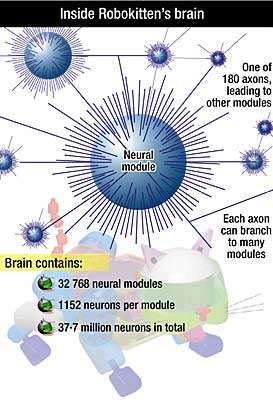|
Robot Kits
Stiquito Kit
BattleKits
Robot Toys
Solar Kits
Robot Arms
Robosapien
Basic Stamp Kits
Lego MindStorms
Beginners
Books
Hobby Robots
Robot Sports
Electronics
Mechanics
Robot Minds
Books for Kids
Robots at Work
Microcontrollers
Advanced Books
Used Books
Real Robots
Robot Motors
Remote Controls
Robot Parts
Robot Tools
Magazines
Robot Videos
Robot News
RoboLinks
Contact
|
Courtesy of New Scientist Magazine
By Duncan Graham-Rowe
The most ambitious artificial brain yet designed is taking shape in a laboratory in
Colorado. The brain's developers aim to link it to a robot kitten called Robokoneko, which
they hope will become one of the first superstars of artificial life.
"Observers won't need a PhD to appreciate that there is a brain behind it," says
Hugo de Garis of Advanced Telecommunications Research in Kyoto, Japan, the brain's
principal architect.
De Garis's Cellular Automata Machine (CAM) brain is being built under contract by
Genobyte, a company in Boulder, Colorado. It will contain nearly 40 million artificial
neurons, compared with the few hundred neurons that most other specialists in artificial
intelligence are working with. The CAM brain differs not only in its immense scale, but
also in the fact that its neurons are real electronic devices rather than software
simulations.
 The CAM brain uses a special type of computer chip called a field
programmable gate array (FPGA). Unlike conventional chips, the circuits in FPGAs can be
reconfigured by altering the connections between their transistors. When de Garis
conceived his project six years ago it was greeted with skepticism. "Many of my
colleagues thought I was nuts," he says. But it has now become a practical
proposition with the development of a new and exceptionally robust FPGA made by Xilinx, a
company in San Jose, California. The CAM brain uses a special type of computer chip called a field
programmable gate array (FPGA). Unlike conventional chips, the circuits in FPGAs can be
reconfigured by altering the connections between their transistors. When de Garis
conceived his project six years ago it was greeted with skepticism. "Many of my
colleagues thought I was nuts," he says. But it has now become a practical
proposition with the development of a new and exceptionally robust FPGA made by Xilinx, a
company in San Jose, California.
The CAM brain will run on 72 linked FPGAs. At any one time these devices will act as a
"module" containing 1152 interconnected neurons. But the devices will be
repeatedly reconfigured to represent 32 768 different modules. The brain remembers how the
modules connect to each other (see Diagram), and uses the outputs of the modules it has
already processed as inputs for others. A cycle through these modules, representing 37.7
million neurons, will be repeated 300 times every second.
To model the brain, de Garis uses some 450 million autonomous "cells"
representing components such as the neurons themselves and the axons and dendrites that
connect them. Each cell consists of several transistors within an FPGA.
Neural networks must be fine-tuned to perform particular tasks. But no human programmer
could write the software needed to refine a network as complex as the CAM brain. Instead,
this will be generated using an approach that simulates biological evolution. Through
random mutations and breeding of the "genetic material" that describes the
structure and connections of the network, the program will be evolved over many
generations to get the optimum design. Robokoneko will not be built until this work has
been completed on a computer simulation of the robot cat.
Some experts, however, doubt whether building ever bigger neural networks will bring any
fundamental insights into the mysteries of cognition, such as how the brain builds a
representation of the world. "The point is that these puzzles are not puzzles because
our neural models are not large enough," argues Igor Aleksander, a neural systems
engineer at Imperial College London.
The CAM brain's developers admit that they can't predict exactly how it will perform when
it is linked to Robokoneko. But they hope it will for the first time allow a robot to
interact with stimuli in its environment to develop the sort of intelligence seen in
animals. "What is so special about this neural network is a much higher degree of
biological relevance," says Michael Korkin of Genobyte.
Subscribe to New Scientist
|
|
 The CAM brain uses a special type of computer chip called a field
programmable gate array (FPGA). Unlike conventional chips, the circuits in FPGAs can be
reconfigured by altering the connections between their transistors. When de Garis
conceived his project six years ago it was greeted with skepticism. "Many of my
colleagues thought I was nuts," he says. But it has now become a practical
proposition with the development of a new and exceptionally robust FPGA made by Xilinx, a
company in San Jose, California.
The CAM brain uses a special type of computer chip called a field
programmable gate array (FPGA). Unlike conventional chips, the circuits in FPGAs can be
reconfigured by altering the connections between their transistors. When de Garis
conceived his project six years ago it was greeted with skepticism. "Many of my
colleagues thought I was nuts," he says. But it has now become a practical
proposition with the development of a new and exceptionally robust FPGA made by Xilinx, a
company in San Jose, California.